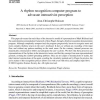79 search results - page 9 / 16 » A Multi-modal Sensing Framework for Human Activity Recogniti... |
CVPR
2011
IEEE
14 years 2 months ago
2011
IEEE
Cameras are ubiquitous everywhere and hold the promise of significantly changing the way we live and interact with our environment. Human activity recognition is central to under...
100
click to vote
HUC
2009
Springer
14 years 8 months ago
2009
Springer
We present two studies of participatory sensing in the wild, in which groups of young people used sensors to collect environmental data along with contextual information such as p...
MOBISYS
2010
ACM
15 years 26 days ago
2010
ACM
We present Darwin, an enabling technology for mobile phone sensing that combines collaborative sensing and classification techniques to reason about human behavior and context on ...
ISWC
2005
IEEE
15 years 4 months ago
2005
IEEE
Children with autism often exhibit self-stimulatory (or “stimming”) behaviors. We present an on-body sensing system for continuous recognition of stimming activity. By creatin...
COGSCI
2004
14 years 10 months ago
2004
This paper advocates the main ideas of the interactive model of representation of Mark Bickhard and the assimilation/accommodation framework of Jean Piaget, through a rhythm recog...

